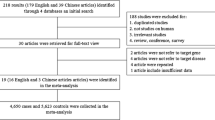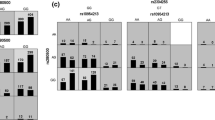Abstract
The purpose of this study was to determine whether toll-like receptor 9 (TLR9) gene polymorphisms were markers of susceptibility to or severity of systemic lupus erythematosus (SLE) in Taiwanese patients. The study included 211 healthy individuals and 167 Chinese patients with SLE. Polymorphisms of TLR9 [rs2066807 and rs187084 (−1486 T/C)] were typed from genomic DNA. The genotypes, allelic frequencies, and carriage rates were compared between patients with SLE and control subjects. The relationship between allelic frequencies and clinical manifestations of 167 patients with SLE was evaluated. There was no statistically significant difference in TLR9 (rs2066807) gene polymorphism, allelic frequency, and carriage rate between the SLE and control groups. However, for the genotype of TLR9 −1486 T/C (rs187084) polymorphism, there was a statistically significant difference between the SLE and the control groups (P < 0.001, χ2 = 15.9). Moreover, there was a significant association between the two groups in allelic frequency and carriage rate of the T allele (P < 0.001, χ2 = 18.5 and P < 0.01, χ2 = 8.06, respectively). We did not detect any association between the TLR9 genotype and the clinical or laboratory profiles in patients with SLE. The results suggest that the TLR9 −1486 T/C (rs187084), but not TLR9 (rs2066807), polymorphism is related to SLE in Taiwanese patients.
Similar content being viewed by others
References
Horwitz DA, Stohl W, Gray JD (1997) T lymphocytes, natural killer cells, cytokines, and immune regulation. In: Wallace DJ, Hahn BH (eds) Dubois’ lupus erythematosus, 5th edn. Williams and Wilkins, Baltimore, pp 155–194
Klinman DM, Steinberg AD (1987) Systemic autoimmune disease arises from polyclonal B cell activation. J Exp Med 165:1755–1760
Hendrich B, Tweedie S (2003) The methyl-CpG binding domain and the evolving role of DNA methylation in animals. Trends Genet 19:269–277
Takeda K, Kaisho T, Akira S (2003) Toll-like receptors. Annu Rev Immunol 21:335–376
Akira S, Takeda K, Kaisho T (2001) Toll-like receptors: critical proteins linking innate and acquired immunity. Nat Immunol 2:675–680
Viglianti GA, Lau CM, Hanley TM et al (2003) Activation of autoreactive B cells by CpG dsDNA. Immunity 19:837–847
Rui L, Vinuesa CG, Blasioli J et al (2003) Resistance to CpG DNA-induced autoimmunity through tolerogenic B cell antigen receptor ERK signaling. Nat Immunol 4:594–600
Leadbetter EA, Rifkin IR, Hohlbaum AM et al (2002) Chromatin-IgG complexes activate B cells by dual engagement of IgM and Toll-like receptors. Nature 416:603–607
Migita K, Miyashita T, Maeda Y et al (2007) Toll-like receptor expression in lupus peripheral blood mononuclear cells. J Rheumatol 34:493–500
Cook DN, Pisetsky DS, Schwartz DA (2004) Toll-like receptors in the pathogenesis of human disease. Nat Immunol 5:975–979
Hur JW, Shin HD, Park BL et al (2005) Association study of toll-like receptor 9 gene polymorphism in Korean patients with systemic lupus erythematosus. Tissue Antigens 65:266–270
De Jager PL, Richardson A, Vyse TJ et al (2006) Genetic variation in toll-like receptor 9 and susceptibility to systemic lupus erythematosus. Arthritis Rheum 54:1279–1282
Tan EM, Cohen AS, Fries JF et al (1982) The 1982 revised criteria for the classification of systemic lupus erythematosus. Arthritis Rheum 25:1271–1277
Tao K, Fujii M, Tsukumo S et al (2007) Genetic variations of toll-like receptor 9 predispose to systemic lupus erythematosus in Japanese population. Ann Rheum Dis 66:905–909
Ng MW, Lau CS, Chan TM, Wong WH, Lau YL (2005) Polymorphisms of the toll-like receptor 9 (TLR9) gene with systemic lupus erythematosus in Chinese. Rheumatology (Oxford) 44:1456–1457
Jaen O, Petit-Teixeira E, Kirsten H et al (2009) No evidence of major effects in several toll-like receptor gene polymorphisms in rheumatoid arthritis. Arthritis Res Ther 11(1):R5
Ronnblom L, Eloranta ML, Alm GV (2006) The type I interferon system in systemic lupus erythematosus. Arthritis Rheum 54(2):408–420
Acknowledgments
This study was supported by a grant (DMR-97-022) from the China Medical University Hospital of Taiwan.
Conflict of interest
None.
Author information
Authors and Affiliations
Corresponding author
Rights and permissions
About this article
Cite this article
Huang, CM., Huang, PH., Chen, CL. et al. Association of toll-like receptor 9 gene polymorphism in Chinese patients with systemic lupus erythematosus in Taiwan. Rheumatol Int 32, 2105–2109 (2012). https://doi.org/10.1007/s00296-011-1925-8
Received:
Accepted:
Published:
Issue Date:
DOI: https://doi.org/10.1007/s00296-011-1925-8




